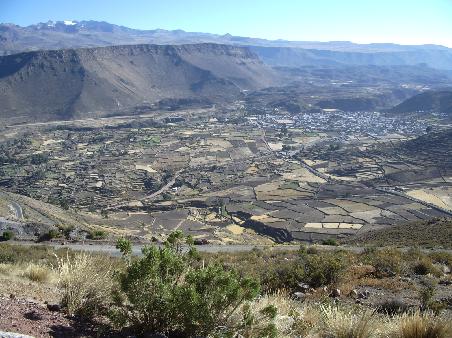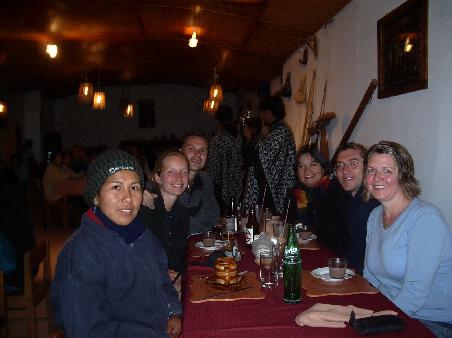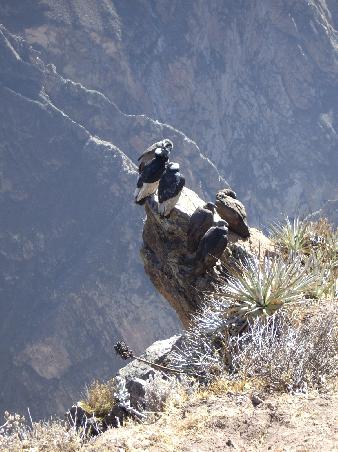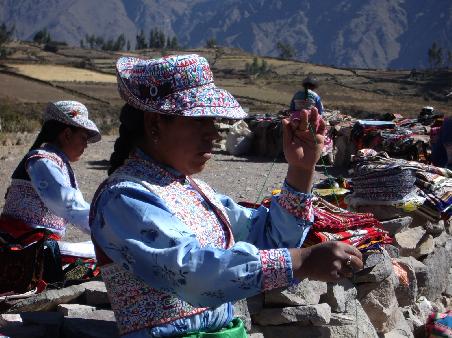Wandering in America del Sur
140 km as the condor flies
Well, 3:30am came early and everyone in the minibus was extremely comatose as we headed out of Arequipa bound for the Colca Canyon. In the pitch dark it was hard to imagine what the landscape was like, but the road was smooth and in 2 hours we were at our first stop - a mandatory rest point to drink some coca leaf tea (allegedly good for altitude sickness though it never worked for me before!). Fishing two soles out with my headlamp, I suspended my disbelief and drank up!
When we emerged, the sun was rising, creating a spectacular vista on the otherwise harsh antiplano landscape. And in the early morning we were treated to magic light for the entire drive reflecting off the mountains and dry sienna landscape where apparently there are over 75 plants despite the harsh conditions.
Drove by herds of llamas and alpacas kept by locals and prized for their currency. For hundreds of years, those living on the antiplano would trade alpaca wool (the softest and most valued of all wools) as well as alpaca meat for vegetables and fruit in neighbouring villages that were located at lower elevations. It was amazing to me that the animals stayed in their simple walled area made of stone. No barbed wire needed.
Continued our climb up past ice flows to the highest point of the drive at 4910m where the guide warned us not to run when we got out of the bus - apparently many tourists do! Not me, the air was rarified at that altitude and all I wanted to do was descend. However, the summit provided a briliant view of several volcanos at over 6000m in the distance.
Heading down to Chivay at 3600m was amazed to see the greenery of rice growing and a patchwork of terraces. Drove outside to a small village, Coparaque, to go for a short hike up above the teraces. Along the way admired all the perfectly formed stone fences that were topped with cactus to keep away evil spirits. And speaking of spirits, we hiked higher and higher to two tombs which had been in existence since preInca times when different tribes lived in that area. According to tradition, they were heavily influenced by the dominant mountain in their area and the people moulded their skulls to mimic the mountain - perfectly conical like one and flat and wide like the other. While there were skeletons and skulls there it was hard to know how old they really were.
By this point, at over 4000m, and with no food, we were all starting to fade, so headed back to Chivay for lunch. The entire town is flourishing on tourism with a proliferation of tourist restaurants and hotels. I tried some Arequipa soup which was made with some cold green sauce, and potatoes and tasted vaguely like satay and local Colca River trout before heading to my hotel.
In the later afternoon, we headed off to the thermal baths or hot springs to indulge. There were one area for locals and then the gringo/as side complete with bar and touristas lounging with drinks in hand looking as though they were somewhere tropical. The two pools felt good and we all floated without a care in the world.
As per our tour program, when we returned to town, we had an hour before dinner at a little restaurant with music and dancers. Chowed down to another three course meal for a mere $4 and were serenaded by 4 musicians wielding bamboo flutes and guitars and big voices who filled up the entire vacuous room. You couldn´t help tapping your feet. Then came the dancers who really upstaged the musicians with their gorgeous clothes. The women in particular had poofy skirts, heavily embroidered with all colours of thread as well as hats to match with upturned brows as was common in that area. As they spun the skirts ballooned out to showcase the stitchwork which was a work of art of its own.
The dances were all cultural and showed some contempt for the Spanish who had tried to supress the local customs of the Quecha. There were also dances about toiling in the fields where the man and woman would work together, but sometimes the man would get distracted and wander off and drink corn beer with others and when he had been gone too long, the woman would ring a bell to summon him back! And then they decided to seek audience participation which ended the night on a light note with everyone going home with their stomachs full and happy knowing just a little more about the local customs and history.
There was no rest for the wicked on this trip as we were awakened at 5:30am to head off to search for the illusive condors. In fact, that is why most of us had come, to see these magnificent birds of flight with their 3m wingspans who can travel hundreds of kilometers in one day.
Headed out along a very rough road that never got any better to the Cruz de Condor. What I didn´t realise was what incredible landscape we were going to be treated to along the dusty drive. On our right was the Colca River and hugging its banks and up the mountains were hundreds of hectares of terracing that went far, far up the mountainside - to places that you wouldn´t expect people to go. With the stone fences dividing the plots and breaking the images, the various colours of wheat, brown, and greens created a patchwork quilt of crops - some of the oldest and most extensive in the world having existed before Inca times.
Stopped before the lookout point to start a brief hike in high winds in hopes of seeing some condors. The wind was ferocious and I was amazed that any birds could take flight because we could barely stand, but in the distance there were two condors. When we got closer to the main tourist area, there appeared 11 condors swooping and gliding effortlessly above the 1200m drop to the river below. We sat and watched, mesmerized as they put on the show of all shows for us as the sunlight flashed on their wings of black and brown and they turned tight circles to land on a rocky outcropping just a few metres from the main lookout.
And when there wasn´t enough room for all of them, they would land on each other´s back until they all shuffled over and made more room, resting until taking flight again. Everyone was delighted and reluctant to leave knowing that we´d been extremely lucky as usually tourists only see one or two condors and some days none. To see so many at one time was pure magic.
Left on a high and then stopped at a few viewpoints and villages along the way where locals had come out with their baby alpacas dressed in their traditional dress, hoping to make money from photographs. I indulged in two different fruits from the cactus that were prolific in that area, one a bright red, called tuna and sweet and the other green with seeds like a giant kiwi, but tart - too sour for me!
Bellies filled we readied ourselves for the 6 hour drive back to Arequipa and wished that we were condors since it was only about 140km, but with a road rougher than the BC logging roads, it was slow going. Left any greenery back in the Colca Canyon and Chivay and headed up, up and away to the antiplano and a headache.
Was so happy when we started to descend and when we got to the national reserve area which protects 367,000 ha at an average altitude of 3850m were lucky enough to see not only herds of alpacas and llamas, but their delicate camelid cousins, the vicunas who are smaller and striking with their reddish brown, fox like colouring.
When we hit the asphalt we knew that our headaches were over, but also, that we were leaving the land of the Colca Canyon and the antiplano behind in all its spectacular beauty. I am sure that as the hoards of tourists continue to descend on this otherwise fairly remote area, it will change and one day, very soon, the rough road where the condors fly overhead will be only history.
Next, heading to more history in Cuzco, heart of the Inca territory ...

Lookng down onto the terracing of Chivay

The dancers in Chivay

The highest point in the trip - 4910m

The group at dinner in Chivay

The condors on their roost


The local women with their incredible hand embroidered clothes
| Start of journey: | Jul 05, 2005 |
| Duration: | 8 months |
| End of journey: | Mar 02, 2006 |
Chile
Argentina
Uruguay
Ecuador